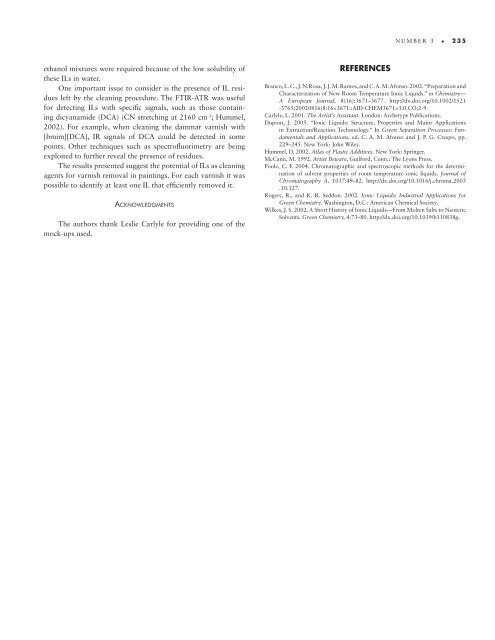You also want an ePaper? Increase the reach of your titles
YUMPU automatically turns print PDFs into web optimized ePapers that Google loves.
number 3 • 235<br />
ethanol mixtures were required because <strong>of</strong> <strong>the</strong> low solubility <strong>of</strong><br />
<strong>the</strong>se ILs in water.<br />
One important issue to consider is <strong>the</strong> presence <strong>of</strong> IL residues<br />
left by <strong>the</strong> cleaning procedure. The FTIR- ATR was useful<br />
for detecting ILs with specific signals, such as those containing<br />
dicyanamide (DCA) (CN stretching at 2160 cm - 1 ; Hummel,<br />
2002). For example, when cleaning <strong>the</strong> dammar varnish with<br />
[bmim][DCA], IR signals <strong>of</strong> DCA could be detected in some<br />
points. O<strong>the</strong>r techniques such as spectr<strong>of</strong>luorimetry are being<br />
exploited to fur<strong>the</strong>r reveal <strong>the</strong> presence <strong>of</strong> residues.<br />
The results presented suggest <strong>the</strong> potential <strong>of</strong> ILs as cleaning<br />
agents for varnish removal in paintings. For each varnish it was<br />
possible to identify at least one IL that efficiently removed it.<br />
Acknowledgments<br />
The authors thank Leslie Carlyle for providing one <strong>of</strong> <strong>the</strong><br />
mock- ups used.<br />
REFERENCES<br />
Branco, L. C., J. N.Rosa, J. J. M. Ramos, and C. A. M. Afonso. 2002. “Preparation and<br />
Characterization <strong>of</strong> <strong>New</strong> Room Temperature Ionic Liquids.” in Chemistry —<br />
A European Journal, 8(16):3671–3677. http://dx.doi.org/10.1002/1521<br />
- 3765(20020816)8:163.0.CO;2- 9.<br />
Carlyle, L. 2001. The Artist’s Assistant. London: Archetype Publications.<br />
Dupont, J. 2005. “Ionic Liquids: Structure, Properties and Major Applications<br />
in Extraction/Reaction Techonology.” In Green Separation Processes: Fundamentals<br />
and Applications, ed. C. A. M. Afonso and J. P. G. Crespo, pp.<br />
229–245. <strong>New</strong> York: John Wiley.<br />
Hummel, D. 2002. Atlas <strong>of</strong> Plastic Additives. <strong>New</strong> York: Springer.<br />
McCann, M. 1992. Artist Beware, Guilford, Conn.: The Lyons Press.<br />
Poole, C. F. 2004. Chromatographic and spectroscopic methods for <strong>the</strong> determination<br />
<strong>of</strong> solvent properties <strong>of</strong> room temperature ionic liquids. Journal <strong>of</strong><br />
Chromatography A, 1037:49–82. http://dx.doi.org/10.1016/j.chroma.2003<br />
.10.127.<br />
Rogers, R., and K. R. Seddon. 2002. Ionic Liquids: Industrial Applications for<br />
Green Chemistry. Washington, D.C.: American Chemical Society.<br />
Wilkes, J. S. 2002. A Short History <strong>of</strong> Ionic Liquids—From Molten Salts to Neoteric<br />
Solvents. Green Chemistry, 4:73–80. http://dx.doi.org/10.1039/b110838g.
















